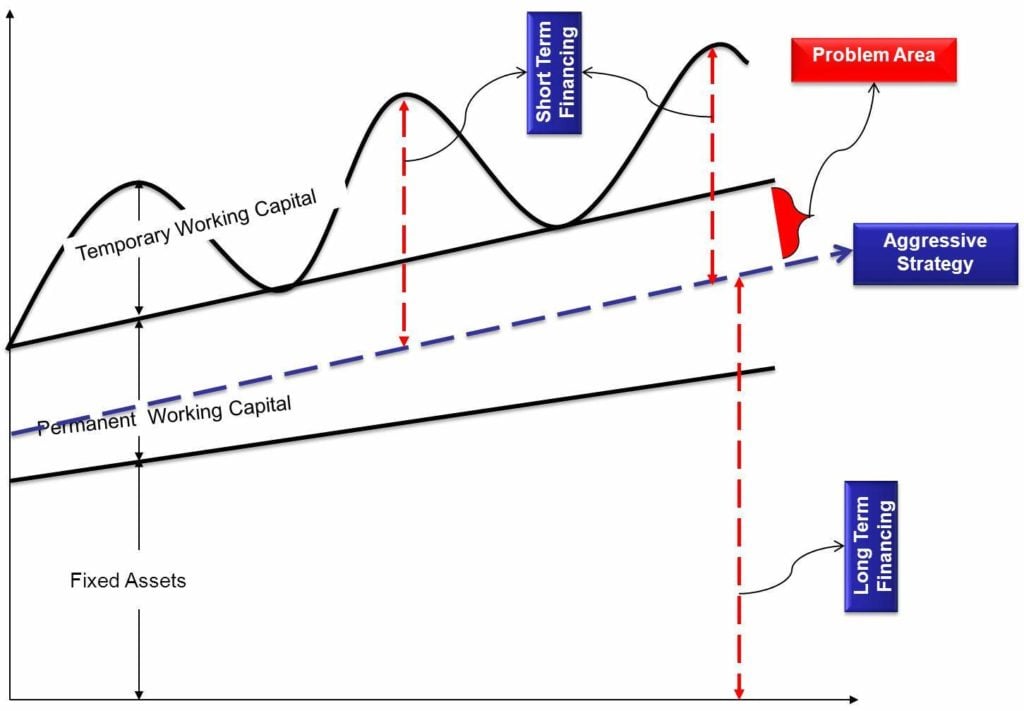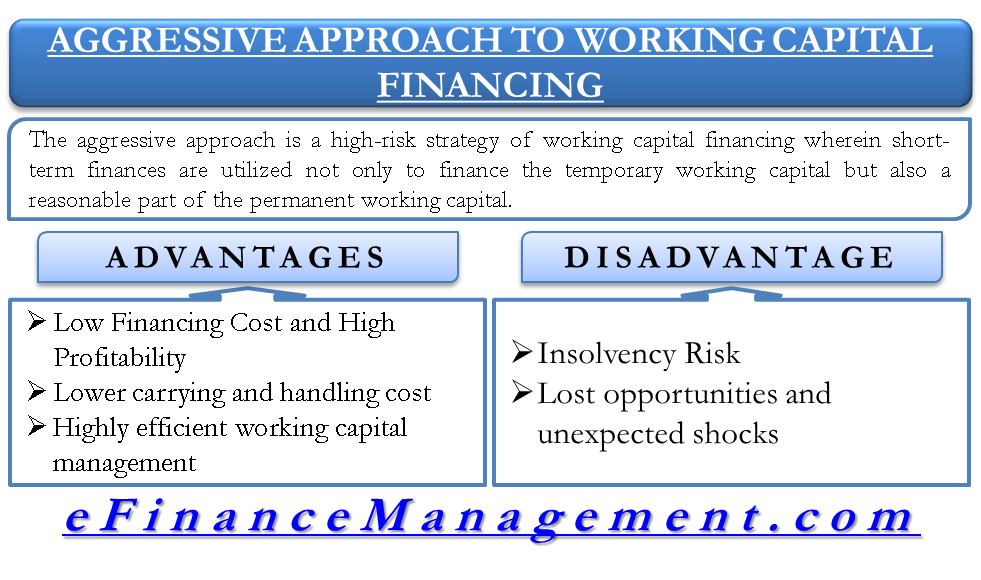The aggressive approach is a high-risk strategy of working capital financing wherein short-term finances are utilized to finance the temporary working capital and a reasonable part of the permanent working capital. In this approach to financing, the levels of inventory, accounts receivables, and bank balances are just sufficient with no cushion for uncertainty. There is a reasonable dependence on trade credit. Let us see more about the aggressive working capital policy.
Long-term financing sources finance fixed assets and a part of permanent working capital. Short-term financing sources only finance the remaining part of permanent working capital and total temporary working capital. It is explained in the equation below:
Financing Strategy in Equation
Long Term Funds will Finance = Fixed Assets + Part of Permanent Working Capital.
Short Term Funds will Finance = Remaining Part of Permanent Working Capital + Temporary Working Capital.
Aggressive Approach Diagram
For a better and clear understanding, the following diagram is utilized. The horizontal dotted lines indicate the point to which the long-term funds will be used. The dotted vertical lines indicate the sources of finance, and they are tagged as ‘long-term financing’ and ‘short term financing.’

We can easily make out that long-term funds are financing total fixed assets and a part of permanent assets. A short-term source of finance finances a major part of Seasonal requirements or temporary working capital. In this approach, the difficult area is the part of permanent working capital, which is financed by short-term sources. It can pose problems of liquidity and bankruptcy to the firm.
Continue reading: Maturity Matching or Hedging Approach & Conservative Approach to Working Capital Financing.
Advantages of Aggressive Strategy of Working Capital Financing
The aggressive working capital policy has some advantages, let them discuss below.
Lower Financing Cost, High Profitability
In this strategy, the interest cost is low because of the maximum usage of short-term finances. There are two reasons for this. Firstly, the interest rate is cheaper, and secondly, in the off-seasons, the loan can be repaid and hence, no idle funds. If the operating cycle moves smoothly, it is the most effective working capital management.
Lower Carrying and Handling Cost
A lower inventory level makes the carrying and holding costs also go down, which directly affects profitability.
Highly Efficient Working Capital Management
The task of the working capital manager is to smoothly run the operating cycle of the company with the lowest level of working capital. Precisely, that is what this strategy is all about. If the strategy is successful with no dissatisfied stakeholders, there is nothing better than this.

Disadvantages of Aggressive Strategy of Working Capital Financing
Insolvency Risk
This strategy faces a high level of insolvency risk because short-term financing sources finance the permanent assets. To maintain those permanent assets, the firm would need repeated refinancing and renewals. It is not necessary that all the time, the refinancing is smooth. For any reason, if the financial institution rejects the renewal, the firm will not be in a position to maintain those permanent assets and will have to sell them forcibly. If you fail in realizing those assets, the option left is liquidation. Liquidating the permanent working capital is very difficult as it consists of accounts receivables and inventory.
Lost Opportunities and Unexpected Shocks
Since there is no cushions or margin in this financing strategy, sudden big contracts of sales are not possible to execute. On the other hand, if there are other uncertainties like delays in abnormal raw material acquisition, machinery breakdowns, etc., the firm will disturb the business operating cycle and, therefore, will face sustainability problems.
Also, read about Different Approaches to Working Capital Financing Strategies.


Very good explanations
Can you please clarify more about aggressive financial approach?
Simple and precise, really very helpful
I could do with a simpler explanation. Still not quite clear about this.
I was really not getting the right notes on the methods of working capital.